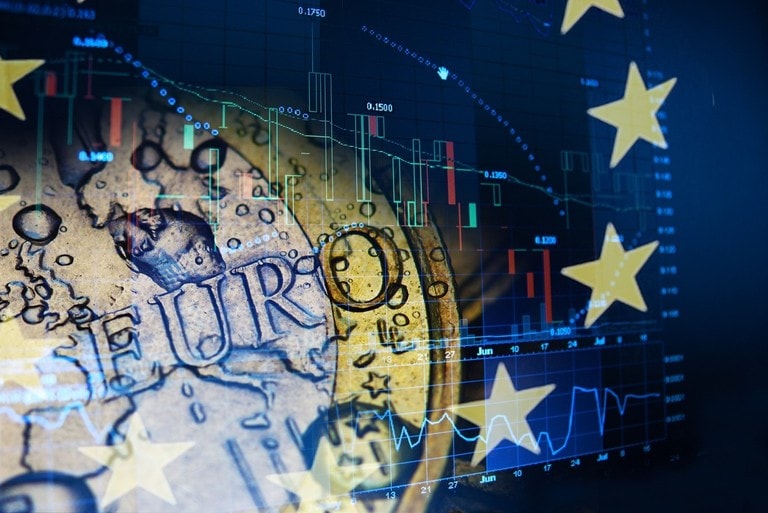Last night’s Fed inspired rate pivot saw a strong start to the day with the DAX and CAC 40 trading up to new record highs, as yields fell sharply across the board in terms of country, as well as duration.
Europe
These strong gains appear to have run out of steam in the afternoon session, after the ECB and Bank of England pushed back on following a similar rate cut outlook, with the DAX finishing the session lower.
The FTSE100 on the other hand has managed to dodge some of this pushback helped in some part by the sharp falls in yields which are helping to provide a lift to the commercial real estate and housing sector. Today’s move has also helped to push the UK index above its 200-day SMA, a key technical level, and to its highest level in almost 3 months.
The basic resources sector is also seeing a strong session as markets price in the possible stimulus effect of multiple cuts for next year, which if they happen could well help to give a solid lift to growth prospects.
It’s also been a strong session for electrical retailer Curry’s after the company reported H1 results that were better than expected due to a recovery in its Nordic operations. H1 revenues came in at £4.16bn a decline of 7%, while the adjusted loss before tax came in at £16m, better than was expected at £30.4m loss. While the UK remains challenging from an EBIT point of view, both Greece and Nordics saw a substantial improvement in earnings. The disposal of the Greece operation is expected to finalise early next year, with full year guidance kept unchanged.
US
With the Dow Jones closing at a new record high yesterday, the focus turns to the Nasdaq 100 and S&P500 to see whether they can follow suit in the wake of last night’s surprise pivot by the US central bank in guiding to rate cuts for next year.
Today’s follow through reaction in Europe has seen US markets carry on from where they left off last night opening sharply higher, with the Russell 2000 leading the way after underperforming for most of this year, as investors become more bullish in the US economy for 2024, with the small cap index pushing above the 2,000 level and its highest levels this year.
The latest economic numbers continue to point to resilience for the US economy and a soft landing after November retail sales rose 0.3%, against an expectation of -0.1%, while weekly jobless claims slipped to 202k from 221k the previous week.
Not everyone has been caught up in last night’s pivot frenzy with Adobeshares sharply lower after reporting guidance that was a little underwhelming, even though the company beat expectations on its Q4 results. For Q1 Adobe said it expects revenue of $5.1bn to $5.15bn and profits of $4.35 to $4.40, however on annual basis saw revenues of $21.4bn midpoint slightly below consensus with the company saying that the AI effect was likely to take longer to bleed through.
FX
The Norwegian Krone surged after the Norge Bank unexpectedly raised rates by 25bps to 4.5%, in a complete contrast to the narrative of only a few hours ago set by the Federal Reserve when chairman Jay Powell signalled the prospect of multiple rate cuts next year. The rationale for the unexpected hike appeared to be driven by concern over recent weakness in the currency which appeared to trump concerns over the weaker macro-outlook.
The Swiss National Bank kept rates unchanged while reserving the option to intervene to weaken the currency, which has seen solid gains in recent weeks.
The pound edged to the highs of the day after the Bank of England also kept rates unchanged but the 3 hawks on the MPC of Mann, Haskel and Greene stuck to their guns in calling for another 25bps rate hike, obviously not persuaded by this week’s disappointing UK economic data.
Of course, this could simply be the Bank of England’s way of pushing back on market expectations of an imminent rate cut and stopping markets getting ahead of themselves, given that a weaker pound can slow the disinflation process when it comes to pulling inflation lower, and is likely something the central bank will want to avoid. Having 3 hawkish outriders can help keep markets guessing.
We’ve also seen significant weakness in the US dollar over the last 24 hours, not surprising given last night’s dovish pivot, with the greenback sliding to a 4-month low against a basket of currencies.
The sudden about turn by the Fed also presented a challenge to the ECB who hiked rates as recently as September, against a backdrop of market concerns they might have to reverse recent hikes quite quickly given the economic weakness already being exhibited across the euro area.
For now, there appears to be little indication the ECB is thinking in those terms, despite headline inflation in the euro area being lower than in the US, and both the German and French economies contracting in Q3.
This comes across as rather odd with the Fed announcing a pivot with Q3 GDP growth of 5% and headline CPI of 3.1%, while the ECB has maintained its hawkish stance when its 2 largest economies showing a contraction in Q3, and its headline inflation rate is lower. Both can’t be right The ECB says it is data dependant yet on that basis it really ought to be leaning towards rate cuts in the same way the Fed already is, and yet it isn’t.
It’s hard to see how that line of no imminent rate cuts can hold if economic data in Europe continues to struggle, and at the moment it looks unambiguously rubbish.
Gold rallied off the 50-day SMA yesterday as yields plunged and the US dollar slid back after last night’s unexpectedly dovish pivot from the Fed yesterday.
The weakness in the US dollar, along with an expectation that we could see multiple rate cuts next year has helped to give oil prices a lift in expectation that any boost from lower rates will offer an economic stimulus to growth prospects next year.
Volatility
Yesterday’s FOMC meeting served to turbocharge the Santa rally for US equities, with that dovish call of three rate cuts being seen in 2024 delivering a slug of festive cheer despite being a less aggressive pace than some analysts had predicted.
Wall Street indices were up across the board, but the news was particularly well received amongst smaller caps with the Russell 2000 index adding more than three and a half percent. One day vol stood at 31.99% against 21.6% on the month.
The news from the Fed initiated buying demand for US treasuries with yields on the 10-year falling below 4% for the first time since August. One day vol on the contract stood at 11.76% against 7.58% on the month. Keeping with that monetary policy outlook, the US dollar also ended up seeing elevated levels of price action.
The most notable trade here was against the Kiwi Dollar with gains of almost a cent being seen as markets absorbed the updated rate outlook. The RBNZ has noted that their rate hike cycle may still have further to run.
One day vol printed 18.46% against 11.7% on the month. That prospect of falling borrowing costs boosted interest in the renewable energy sector, where performance has been blighted post-pandemic because of high interest rates. CMC’s proprietary basket of 18 US stocks covering the sector added more than 6% with one day vol of 80.22% compared with 53.33% for the month.
Disclaimer: CMC Markets is an execution-only service provider. The material (whether or not it states any opinions) is for general information purposes only, and does not take into account your personal circumstances or objectives. Nothing in this material is (or should be considered to be) financial, investment or other advice on which reliance should be placed. No opinion given in the material constitutes a recommendation by CMC Markets or the author that any particular investment, security, transaction or investment strategy is suitable for any specific person. The material has not been prepared in accordance with legal requirements designed to promote the independence of investment research. Although we are not specifically prevented from dealing before providing this material, we do not seek to take advantage of the material prior to its dissemination.







